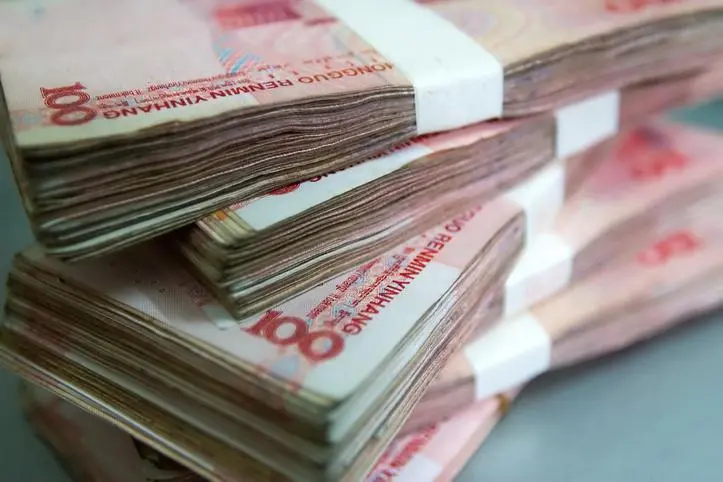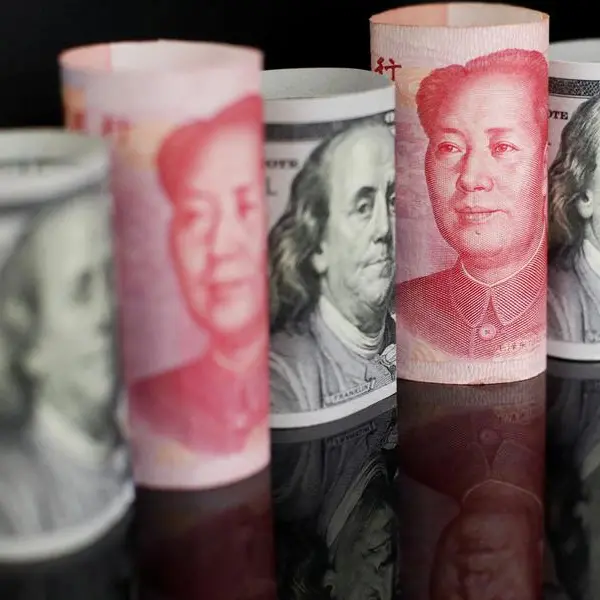PHOTO
China's yuan ended its domestic session at a 27-month low against a surging dollar on Thursday, after the U.S. Federal Reserve delivered another 75-basis-point interest rate rise and signalled more hikes in coming months.
The onshore yuan closed the domestic session at 7.0810 per dollar, the weakest such close since June 18, 2020. And it was 333 pips, or 0.47%, softer than the previous late night close of 7.0477.
Its offshore counterpart breached the key 7.1 per dollar level before trading at 7.0844 around 0830 GMT.
The yuan weakness came after Fed Chair Jerome Powell vowed on Wednesday that he and his fellow policymakers would "keep at" their battle to beat down inflation. In a sobering new set of projections, the Fed foresees its policy rate rising at a faster pace and to a higher level than expected.
The Fed's more hawkish stance than many market participants had anticipated pushed the dollar to a fresh two-decade high and put pressure on emerging market currencies.
Prior to the market's opening, the People's Bank of China (PBOC) set the midpoint rate at 6.9798 per dollar, 262 pips or 0.38% weaker than the previous fix of 6.9536, the softest since Aug. 4, 2020.
But the official guidance came in much stronger than market projections for a 21st straight trading day, traders and analysts said, noting this was part of an official attempt to stem fast yuan declines. Thursday's midpoint was 148 pips firmer than Reuters' estimate of 6.9946.
"The dollar was too strong," said Ken Cheung, chief Asian FX strategist at Mizuho Bank.
"This round of yuan depreciation was triggered by the buoyant dollar, and the midpoint fixing should remain the key tool (to stabilise the market)."
The yuan is not the only victim. Both China and Japan are among major outliers in a global run of interest rate hikes to tame inflation, but widening policy divergence has hurt their currencies.
Japan intervened in the currency market on Thursday for the first time since 1998 to shore up the battered yen, in the wake of its central bank's decision to maintain ultra-low interest rates.
"The PBOC is likely to continue to lean against the move (in USD/CNY) higher, but is unlikely to try to stabilise USD/CNY if the broad USD continues to gain," Lemon Zhang, FX strategist at Barclays, said in a note.
"Going forward, we expect the PBOC to adopt more counter-cyclical policy choices from its toolkit, especially ahead of the Party Congress on Oct. 16, such as further FX reserve requirement ratio (RRR) cuts and stronger CNY bias in the daily fixing."
Zhang expects the yuan to hit 7.15 by the fourth quarter of this year.
China lowered the FX RRR earlier this month to slow the pace of yuan losses, and investors widely expect the authorities to roll out more policy measures should the weakness be sustained.
Some currency traders said the 7.1 per dollar level should continue to offer strong resistance to the onshore market, as it was not far from the lower end of the daily trading band of 7.1194.
China's onshore yuan can only trade in a narrow range of 2% around the daily midpoint fixing, and Thursday's guidance rate capped the range to between 6.8402 and 7.1194.
"The hard defence line could be around 7.18 per dollar for this round of depreciation," said a trader at a foreign bank.
The trader said the level was last hit during the height of Sino-U.S. trade tensions in 2019 and has also acted as a floor for the yuan since the global financial crisis of 2008. (Reporting by Winni Zhou and Brenda Goh; Editing by Ana Nicolaci da Costa, Richard Pullin and Uttaresh.)












